Gardeners and farmers alike know that unexpected problems can arise with any crop. Unfortunately, one of these common problems is spotting, leaving many gardeners wondering: why does my cabbage have black spots?
The leading causes of black spots on cabbage plants are conditions called Alternaria Leaf Spot and Bacterial Soft Rot. Additionally, Napa cabbages can be affected by a condition called Pepper Spot, which also causes them to have tiny black spots.
In this article, we will describe these three causes of black spots on cabbages in more detail. We will also explain how you can treat and prevent these conditions. Let’s get right into it.

What Causes Cabbage To Have Black Spots?
There are a few common cause to black spots on cabbage:
Cabbages Can Get Alternaria Leaf Spot
Alternaria Leaf Spot is a fungal disease that causes cabbages to have black spots on their leaves. These spots start off as being quite small, but larger black spots will develop over time.
Most of the time, these spots are surrounded by a halo of yellow discoloration. Similarly, these spots typically begin on the outermost leaves of the cabbage plant and then move inward as the infection progresses.
The fungus that causes Alternaria Leaf Spot, Alternaria brassicicola, thrives in a humid and cool environment. This means that most Alternaria Leaf Spot infections begin when there is a lot of rainfall in temperatures ranging from 55 to 75 degrees Fahrenheit.
However, it is important to mention that this fungus can still survive in temperatures higher than this, especially once it has taken root in a garden.
Alternaria Leaf Spot is mainly spread by smaller insects that eat and live around cabbage plants, flea beetles being one of the main culprits. Wind and rain can also carry the fungus causing Alternaria Leaf Spot from nearby infected plants to yours.

Napa Cabbage Can Be Affected By A Disorder Called Pepper Spot
Napa cabbages can be affected by a condition called Pepper Spot, which causes the cabbage leaves to have tiny black spots.
The spots appear similar to cabbage with some black pepper sprinkled on it, and this is where the condition gets its name. These spots first appear on the cabbage plant’s outer leaves, then slowly spread to the inner leaves.
This is a purely cosmetic condition that is not spread by pests. The exact causes of Pepper Spot are unknown. As of now, it is believed that Pepper Spot can develop as a result of a mixture of environmental and genetic factors. This is because, although Pepper Spot is likely passed genetically, some environmental conditions are believed to make Pepper Spot worse.
After some research from the University of Florida, it has been concluded that high levels of nitrogen and phosphorus in the soil could worsen Pepper Spot in Napa cabbages that already have the condition. Similarly, acidic pH levels around 8.0 could also worsen Pepper Spot in already affected Napa cabbages.
Bacterial Soft Rot Can Cause Large Black Spots On Cabbages
Bacterial Soft Rot causes cabbages to have large black spots that are soft or mushy to the touch. Many gardeners also report a foul smell in crops infected with Bacterial Soft Rot.
Bacterial Soft Rot thrives in warm and moist environments. Temperatures between 75 and 82 degrees Fahrenheit are optimal for this condition. Similarly, damage to the cabbage plants from pests or other factors could make them more susceptible to this bacterial infection.

What Can You Do To Save A Cabbage With Alternaria Leaf Spot?
The main way you can get rid of Alternaria Leaf Spot on cabbages is through fungicides. Organic, gentler fungicides are effective for cabbage plants with very new and minor Alternaria infections.
Some great options for gentler fungicides include liquid copper fungicides and sulfur-based plant fungicides. Harsher, chemical-based fungicides are usually the best option for more advanced Alternaria infections.
Additionally, you will want to eliminate any pests around your cabbage plants. This is because small insects can spread the Alternaria fungus to other plants and worsen the existing Alternaria Leaf Spot conditions. Using your preferred insect removal method, such as neem oil or insecticidal soaps, will work.
Can You Save A Cabbage With Bacterial Soft Rot?
Unfortunately, there is not much that you can do for a cabbage that is infected with Bacterial Soft Rot. Getting rid of infected plants is the best way to prevent the bacteria from spreading to other plants. When getting rid of these plants, it is best to burn them or throw them away. Placing plants infected with Bacterial Soft rot into compost or surrounding soil will spread the disease.

Do You Need To Do Anything For Pepper Spot?
Pepper Spot is a cosmetic condition in Napa cabbage that makes the crop much less marketable. Although preventing this condition is difficult, it is believed that reducing your soil pH levels and altering your fertilizer to one that is less nitrogen and phosphorus-rich can help.
Things To Consider
You may want to consider some other things about cabbages having black spots. These things include whether or not Napa cabbages with pepper spots are safe to eat and how you can prevent your cabbages from getting Alternaria Leaf Spot and Bacterial Soft Rot. Here are some additional things to consider regarding cabbages having black spots.
Are Napa Cabbages With Pepper Spots Safe To Eat?
Yes, Napa cabbages with pepper spots are safe to eat. This is because research has determined Pepper Spot to be purely cosmetic. This means that Pepper Spot affects the appearance of the Napa cabbage, not the flavor, and it does not rot the plant. However, Napa cabbages with Pepper Spots are not marketable, so you should not sell them.
How Can You Prevent Your Cabbages From Getting Alternaria Leaf Spot Or Bacterial Soft Rot?
Luckily, there are some things that you can do to prevent both Alternaria Leaf Spot and Bacterial Soft Rot. Here are some things that will set you up for having a successful cabbage harvest.
- Only buy certified clean seeds from reputable sources
- Weed your garden regularly
- Completely remove all plant debris and dead plants
- Keep an eye out for pests and remove them as soon as possible
- Feed your cabbages a good fertilizer that is rich in calcium
- Prevent your cabbage plants from becoming damaged
- Keep excessive moisture away from your cabbages. Place a tarp over your cabbage plants when there is heavy rainfall.

Hi there, my name is Allie and welcome to my blog; GareningWithAllie!
Much of what you see written here is just our personal experiences with gardening. Along with the content I write here, there is also a unique collection of gardening topics covered by some of our close friends. I hope you find everything you read here to be helpful, informative, and something that can make your gardening journey the most lovely experience ever! With that said, Happy Gardening!
